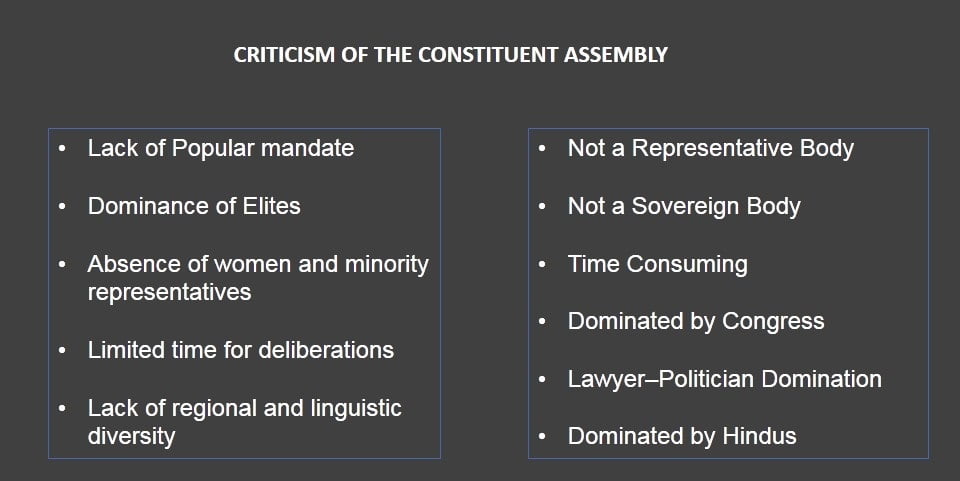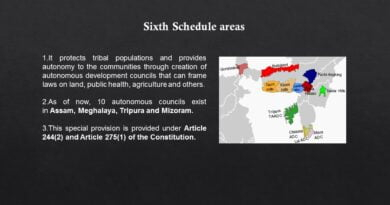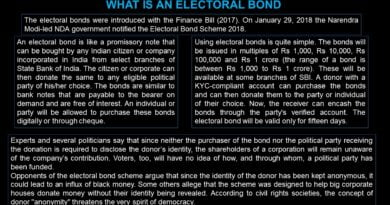Criticism of the Constituent Assembly of India: An Analysis
Introduction
The Constituent Assembly of India holds a prominent place in the country’s history as the body responsible for drafting the Constitution. It comprised representatives from diverse backgrounds and ideologies, striving to create a blueprint for an independent and democratic nation. While the Constituent Assembly’s achievements are undeniable, it is crucial to examine and acknowledge the criticisms raised against its functioning and decision-making processes. This article aims to shed light on some of the significant criticisms levied against the Constituent Assembly of India.
Criticism of the Constituent Assembly of India
- Lack of Popular Mandate/Not a Representative Body
One of the primary criticisms directed at the Constituent Assembly was its composition. The Assembly’s members were not directly elected by the people but rather appointed by provincial legislatures and princely states. Critics argue that this lack of a direct popular mandate (elected by adult franchise) undermined the Assembly’s democratic legitimacy, as the representatives did not directly reflect the will of the people.
- Dominance of Elites
Another criticism pertains to the dominance of elites within the Constituent Assembly. Many members hailed from privileged backgrounds, with substantial educational qualifications and political influence. Critics argue that this resulted in a skewed representation, with the interests and concerns of the common masses being overlooked or marginalized. The lack of diverse voices and perspectives could have limited the effectiveness of the Assembly in addressing the needs of the entire population.
- Absence of Women and Minority Representation
The Constituent Assembly’s failure to adequately represent women and minority groups has also been a subject of criticism. With only 15 women among the 389 members, the Assembly’s gender imbalance was apparent. Similarly, the representation of marginalized communities, such as Dalits and tribal groups, was insufficient. Critics argue that the exclusion of these groups from the drafting process could have resulted in a constitution that did not fully address their unique concerns and rights.
- Limited Time for Deliberations
The Constituent Assembly faced significant time constraints in drafting the Constitution. The Assembly’s members were under immense pressure to complete the task within a fixed timeframe due to mounting political and administrative challenges. Critics argue that this limited time for deliberations may have compromised the quality of discussions and debates, preventing a thorough examination of various provisions. This time constraint may have also hindered broader public participation in the constitution-making process.
- Lack of Regional and Linguistic Diversity
The Constituent Assembly’s representation from different regions and linguistic groups has also been a subject of criticism. Critics argue that certain regions, especially those with distinct cultural and linguistic identities, were underrepresented or not adequately represented in the Assembly. This may have led to the neglect of regional concerns and aspirations, potentially affecting the federal nature of the Indian Constitution.

6. Not a Sovereign Body:
The critics maintained that the Constituent Assembly was not a sovereign body as it was created by the proposals of the British Government. Further, they said that the Assembly held its sessions with the permission of the British Government.
7. Time Consuming:
According to the critics, the Constituent Assembly took unduly long time to make the Constitution. They stated that the framers of the American Constitution took only four months to complete their work.
8. Dominated by Congress:
The critics charged that the Constituent Assembly was dominated by the Congress party. Granville Austin, a British Constitutional expert, remarked: ‘The Constituent Assembly was a one-party body in an essentially one-party country. The Assembly was the Congress and the Congress was India’.
9. Lawyer–Politician Domination:
It is also maintained by the critics that the Constituent Assembly was dominated by lawyers and politicians. They pointed out that other sections of the society were not sufficiently represented. This, to them, is the main reason for the bulkiness and complicated language of the Constitution.
10. Dominated by Hindus:
According to some critics, the Constituent Assembly was a Hindu dominated body. Lord Viscount Simon called it ‘a body of Hindus’. Similarly, Winston Churchill commented that the Constituent Assembly represented ‘only one major community in India’.
Conclusion
While the Constituent Assembly of India played a pivotal role in shaping the nation’s democratic fabric, it is essential to critically analyze its shortcomings. The criticisms raised against the Assembly encompass issues of legitimacy, representation, gender disparity, time constraints, and regional diversity. Recognizing these criticisms is crucial for a comprehensive understanding of the constitutional process and for fostering a continuous dialogue on how to address these concerns in the ongoing quest for a more inclusive and representative democracy. By acknowledging these criticisms, India can strive towards ensuring a more robust and participatory democratic framework for its citizens.



